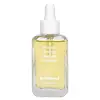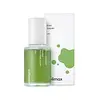What's inside
What's inside
 Key Ingredients
Key Ingredients

 Benefits
Benefits

 Concerns
Concerns

 Ingredients Side-by-side
Ingredients Side-by-side

Houttuynia Cordata Extract
Skin ConditioningPropolis Extract
Skin ConditioningGlycerin
HumectantPropanediol
SolventIsopentyldiol
Humectant1,2-Hexanediol
Skin ConditioningWater
Skin ConditioningSodium Hyaluronate
HumectantOcimum Sanctum Leaf Extract
Skin ConditioningCorallina Officinalis Extract
Skin ConditioningPortulaca Oleracea Extract
Skin ConditioningPunica Granatum Fruit Extract
AntioxidantHamamelis Virginiana Extract
AntiseborrhoeicMelia Azadirachta Flower Extract
Skin ConditioningPanthenol
Skin ConditioningPerilla Frutescens Extract
Skin ConditioningCurcuma Longa Root Extract
MaskingLactobacillus Ferment
Skin ConditioningMelia Azadirachta Leaf Extract
Skin ConditioningButylene Glycol
HumectantAmmonium Acryloyldimethyltaurate/Vp Copolymer
Betaine
HumectantXanthan Gum
EmulsifyingEthylhexylglycerin
Skin ConditioningDisodium EDTA
Zinc PCA
HumectantPantolactone
HumectantHouttuynia Cordata Extract, Propolis Extract, Glycerin, Propanediol, Isopentyldiol, 1,2-Hexanediol, Water, Sodium Hyaluronate, Ocimum Sanctum Leaf Extract, Corallina Officinalis Extract, Portulaca Oleracea Extract, Punica Granatum Fruit Extract, Hamamelis Virginiana Extract, Melia Azadirachta Flower Extract, Panthenol, Perilla Frutescens Extract, Curcuma Longa Root Extract, Lactobacillus Ferment, Melia Azadirachta Leaf Extract, Butylene Glycol, Ammonium Acryloyldimethyltaurate/Vp Copolymer, Betaine, Xanthan Gum, Ethylhexylglycerin, Disodium EDTA, Zinc PCA, Pantolactone
Morinda Citrifolia Fruit Extract 71.77%
Skin ConditioningButylene Glycol
HumectantPropanediol
SolventGlycerin
Humectant1,2-Hexanediol
Skin ConditioningDiethoxyethyl Succinate
SolventGlyceryl Acrylate/Acrylic Acid Copolymer
HumectantMorinda Citrifolia Seed Oil
Skin ConditioningCeramide NP
Skin ConditioningOlea Europaea Fruit Oil
MaskingButyrospermum Parkii Butter
Skin ConditioningSqualane
EmollientRosmarinus Officinalis Leaf Oil
MaskingMelia Azadirachta Leaf Extract
Skin ConditioningMelia Azadirachta Flower Extract
Skin ConditioningTheobroma Cacao Extract
Skin ConditioningDextrin
AbsorbentPhytosphingosine
Skin ConditioningCholesterol
EmollientSodium Hyaluronate
HumectantHydrogenated Lecithin
EmulsifyingC12-13 Pareth-9
EmulsifyingSodium Polyacryloyldimethyl Taurate
Emulsion StabilisingCaprylic/Capric Triglyceride
MaskingWater
Skin ConditioningAllantoin
Skin ConditioningAdenosine
Skin ConditioningDisodium EDTA
Chlorphenesin
AntimicrobialMorinda Citrifolia Fruit Extract 71.77%, Butylene Glycol, Propanediol, Glycerin, 1,2-Hexanediol, Diethoxyethyl Succinate, Glyceryl Acrylate/Acrylic Acid Copolymer, Morinda Citrifolia Seed Oil, Ceramide NP, Olea Europaea Fruit Oil, Butyrospermum Parkii Butter, Squalane, Rosmarinus Officinalis Leaf Oil, Melia Azadirachta Leaf Extract, Melia Azadirachta Flower Extract, Theobroma Cacao Extract, Dextrin, Phytosphingosine, Cholesterol, Sodium Hyaluronate, Hydrogenated Lecithin, C12-13 Pareth-9, Sodium Polyacryloyldimethyl Taurate, Caprylic/Capric Triglyceride, Water, Allantoin, Adenosine, Disodium EDTA, Chlorphenesin
 Reviews
Reviews

Ingredients Explained
These ingredients are found in both products.
Ingredients higher up in an ingredient list are typically present in a larger amount.
1,2-Hexanediol is a synthetic liquid and another multi-functional powerhouse.
It is a:
- Humectant, drawing moisture into the skin
- Emollient, helping to soften skin
- Solvent, dispersing and stabilizing formulas
- Preservative booster, enhancing the antimicrobial activity of other preservatives
Butylene Glycol (or BG) is used within cosmetic products for a few different reasons:
Overall, Butylene Glycol is a safe and well-rounded ingredient that works well with other ingredients.
Though this ingredient works well with most skin types, some people with sensitive skin may experience a reaction such as allergic rashes, closed comedones, or itchiness.
Learn more about Butylene GlycolDisodium EDTA plays a role in making products more stable by aiding other preservatives.
It is a chelating agent, meaning it neutralizes metal ions that may be found in a product.
Disodium EDTA is a salt of edetic acid and is found to be safe in cosmetic ingredients.
Learn more about Disodium EDTAGlycerin is already naturally found in your skin. It helps moisturize and protect your skin.
A study from 2016 found glycerin to be more effective as a humectant than AHAs and hyaluronic acid.
As a humectant, it helps the skin stay hydrated by pulling moisture to your skin. The low molecular weight of glycerin allows it to pull moisture into the deeper layers of your skin.
Hydrated skin improves your skin barrier; Your skin barrier helps protect against irritants and bacteria.
Glycerin has also been found to have antimicrobial and antiviral properties. Due to these properties, glycerin is often used in wound and burn treatments.
In cosmetics, glycerin is usually derived from plants such as soybean or palm. However, it can also be sourced from animals, such as tallow or animal fat.
This ingredient is organic, colorless, odorless, and non-toxic.
Glycerin is the name for this ingredient in American English. British English uses Glycerol/Glycerine.
Learn more about GlycerinMelia Azadirachta Flower Extract is from the Neem tree. Neem trees originate from India.
Melia Azadirachta Flower Extract contains antioxidants. Antioxidants help fight free-radicals. Free-radicals are molecules that may damage your skin cells, such as pollution.
The flowers of this tree are lilac colored.
Learn more about Melia Azadirachta Flower ExtractMelia Azadirachta Leaf Extract is extract from the neem plant.
The leaves of this tree contain flavonoids and polyphenols. These two compounds are antioxidants, anti-inflammatory, and antibacterial. Further research is needed as to their effects when applied on skin.
Propanediol is an all-star ingredient. It softens, hydrates, and smooths the skin.
It’s often used to:
Propanediol is not likely to cause sensitivity and considered safe to use. It is derived from corn or petroleum with a clear color and no scent.
Learn more about PropanediolSodium Hyaluronate is hyaluronic acid's salt form. It is commonly derived from the sodium salt of hyaluronic acid.
Like hyaluronic acid, it is great at holding water and acts as a humectant. This makes it a great skin hydrating ingredient.
Sodium Hyaluronate is naturally occurring in our bodies and is mostly found in eye fluid and joints.
These are some other common types of Hyaluronic Acid:
Learn more about Sodium HyaluronateWater. It's the most common cosmetic ingredient of all. You'll usually see it at the top of ingredient lists, meaning that it makes up the largest part of the product.
So why is it so popular? Water most often acts as a solvent - this means that it helps dissolve other ingredients into the formulation.
You'll also recognize water as that liquid we all need to stay alive. If you see this, drink a glass of water. Stay hydrated!
Learn more about Water